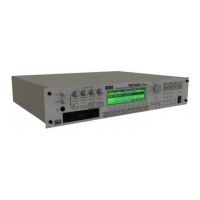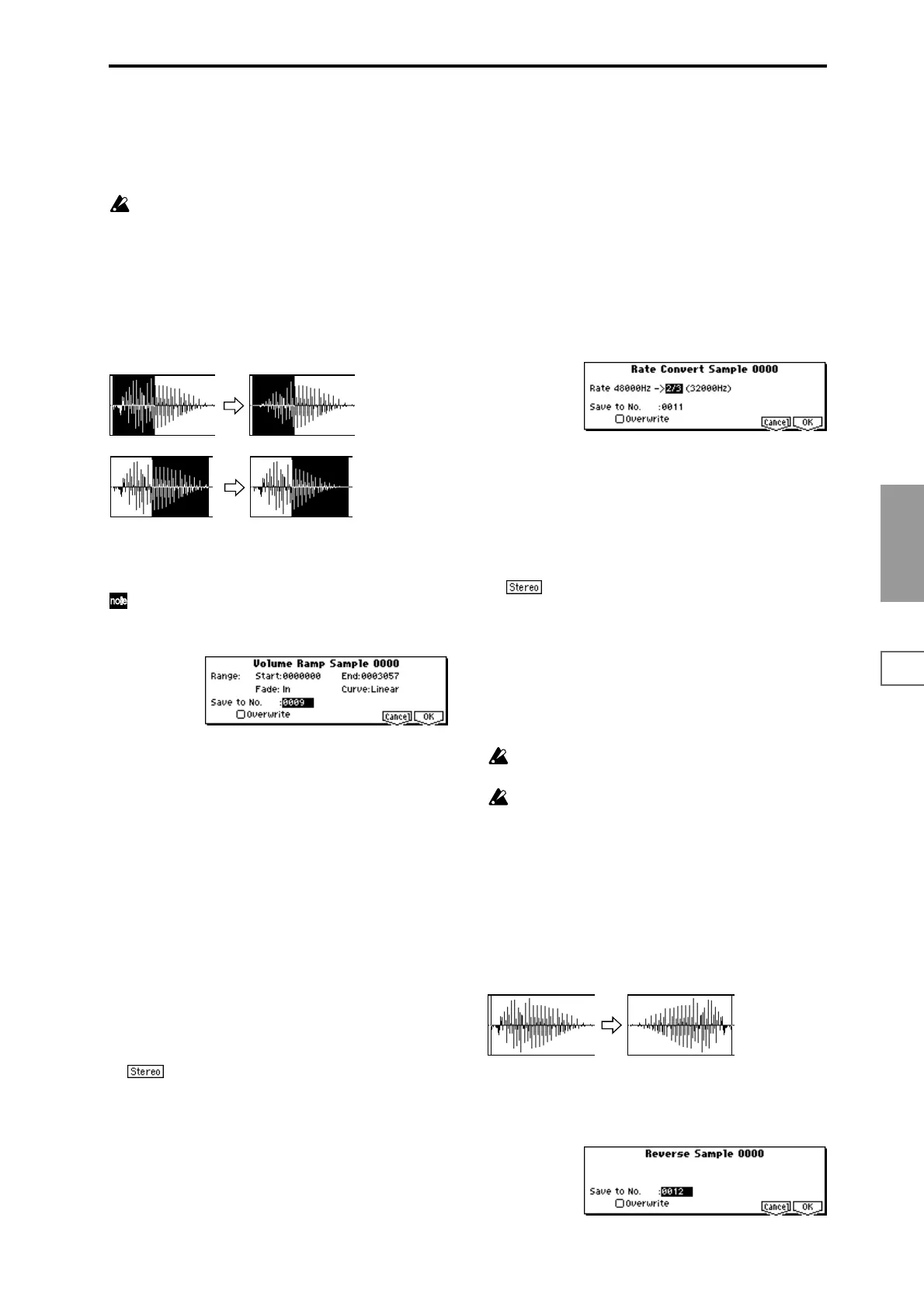SMPL
1.1
2.13.14.15.15.27.2
89
ting, and execute without checking “Overwrite.” (☞p.85
“*”: About “Overwrite”)
7 To execute the Normalize/Level Adjust command, press
the [F8] (“OK”) key. To cancel, press the [F7] (“Cancel”)
key.
Be aware that if sample data of an extremely low level
is normalized, any noise included in the sample will
also be amplified.
Volume Ramp
This command modifies the data values (volume) between
the “S (Edit Range Start)” and “E (Edit Range End).” You
can make the volume gradually increase (Fade In) or
decrease (Fade Out) from the “S (Edit Range Start)” to the “E
(Edit Range End).”
1 Use “SMPL” (2.1–1a) to select the sample that you wish
to edit, and use “S (Edit Range Start)” and “E (Edit Range
End)” (2.1–1b) to specify the editing range.
You can press the [AUDITION] key to hear the portion
on which “Volume Ramp” will be executed.
2 Select “Volume Ramp” to open the following dialog box.
3 The range to be edited is shown by Range “Start” and
“End.”
4 Use “Fade” to select the type of volume ramp.
In: The volume will be zero at Range “Start,” and will
gradually increase toward the “End” volume.
Out: The volume will gradually decrease from the Range
“Start” volume, and will reach zero at the “End” volume.
5 In “Curve,” specify the way in which the volume will
change.
Linear: The volume will change linearly. For normal
fade-in or fade-out, select Linear.
Power: The volume will change non-linearly. When you
use “Mix” (2.1–2e) to combine a faded-in waveform with
a different faded-out waveform (i.e., crossfade), using a
Linear fade-in/out may produce an impression that the
volume has dropped in the middle of the curve. In such
cases, use Power to perform the fade-in/out.
6 In “Save to No.,” specify the save destination sample
number. By default, an unused sample number will be
selected. If you have checked “Overwrite,” this cannot be
set.
For a stereo sample, “Save to No.(L)” and “(R)”
will be displayed. Specify the save destination sample
number for the L channel and R channel respectively.
7 If you wish to delete the original sample data and over-
write it with the edited sample data, check “Overwrite”.
Normally, you will leave “Save to No.” at its default set-
ting, and execute without checking “Overwrite.” (
☞p.85
“*”: About “Overwrite”)
8 To execute the Volume Ramp command, press the [F8]
(“OK”) key. To cancel, press the [F7] (“Cancel”) key.
Rate Convert
This command lowers the sampling rate (frequency) of the
sampled data by 2/3, 1/2, 1/3, 1/4, or 1/6. The sampling
frequency of input is fixed at 48 kHz, but you can use this
command to create “down-sampling” effects. The sample
data is thinned to convert it into sample data of a lower sam-
pling frequency.
The “Rate Convert” command is always executed on all
waveform data of the selected sample, regardless of the “S
(Edit Range Start)” and “E (Edit Range End)” (2.1–1b) set-
tings.
1 Use “SMPL” (2.1–1a) to select the sample that you wish
to edit.
2 In the Edit2 page “UTILITY,” choose “Rate Convert” to
open the following dialog box.
3 The sampling rate of the selected sample is shown at the
right of “Rate.” At the right of the “->” you can select the
desired amount of the sampling rate conversion: 2/3, 1/2,
1/3, 1/4, 1/6. The sampling rate following conversion will
be displayed.
4 In “Save to No.,” specify the save destination sample
number. By default, an unused sample number will be
selected. If you have checked “Overwrite,” this cannot be
set.
For a stereo sample, “Save to No.(L)” and “(R)”
will be displayed. Specify the save destination sample
number for the L channel and R channel respectively.
5 If you wish to delete the original sample data and over-
write it with the edited sample data, check “Overwrite”.
Normally, you will leave “Save to No.” at its default set-
ting, and execute without checking “Overwrite.” (
☞p.85
“*”: About “Overwrite”)
6 To execute the Insert Zero command, press the [F8]
(“OK”) key. To cancel, press the [F7] (“Cancel”) key.
This command cannot be executed on a sample whose
sampling rate is less than 11.025 kHz.
Stereo samples must have the same sampling rate.
Although it is possible to select mono multisamples for
-L and -R and convert their sampling rate separately,
they can no longer be handled as a stereo sample in this
case.
Reverse
This command reverses the sample data (i.e., exchanges the
beginning and end).
The “Reverse” command is always executed on all wave-
form data of the selected sample, regardless of the “S (Edit
Range Start)” and “E (Edit Range End)” (2.1–1b) settings.
1 Use “SMPL” (2.1–1a) to select the sample that you wish
to edit.
2 In the Edit2 page “UTILITY,” choose “Reverse” to open
the following dialog box.
Fade In
Fade Out

